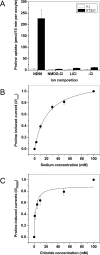Molecular cloning of the mouse IMINO system: an Na+- and Cl--dependent proline transporter
- PMID: 15689184
- PMCID: PMC1134859
- DOI: 10.1042/BJ20050100
Molecular cloning of the mouse IMINO system: an Na+- and Cl--dependent proline transporter
Abstract
Neurotransmitter transporters of the SLC6 family play an important role in the removal of neurotransmitters in brain tissue and in amino acid transport in epithelial cells. Here we demonstrate that the mouse homologue of slc6a20 has all properties of the long-sought IMINO system. The mouse has two homologues corresponding to the single human SLC6A20 gene: these have been named XT3 and XT3s1. Expression of mouse XT3s1, but not XT3, in Xenopus laevis oocytes induced an electrogenic Na+-and-Cl--dependent transporter for proline, hydroxyproline, betaine, N-methylaminoisobutyric acid and pipecolic acid. Expression of XT3s1 was found in brain, kidney, small intestine, thymus, spleen and lung, whereas XT3 prevailed in kidney and lung. Accordingly we suggest that the two homologues be termed 'XT3s1 IMINO(B)' and 'XT3 IMINO(K)' to indicate the tissue expression of the two genes.
Figures



Similar articles
-
Luminal kidney and intestine SLC6 amino acid transporters of B0AT-cluster and their tissue distribution in Mus musculus.Am J Physiol Renal Physiol. 2006 Feb;290(2):F376-83. doi: 10.1152/ajprenal.00286.2005. Epub 2005 Sep 20. Am J Physiol Renal Physiol. 2006. PMID: 16174864
-
Neutral amino acid transport mediated by ortholog of imino acid transporter SIT1/SLC6A20 in opossum kidney cells.Am J Physiol Renal Physiol. 2006 Apr;290(4):F880-7. doi: 10.1152/ajprenal.00319.2005. Epub 2005 Oct 18. Am J Physiol Renal Physiol. 2006. PMID: 16234310
-
Identification of mammalian proline transporter SIT1 (SLC6A20) with characteristics of classical system imino.J Biol Chem. 2005 Mar 11;280(10):8974-84. doi: 10.1074/jbc.M413027200. Epub 2005 Jan 4. J Biol Chem. 2005. PMID: 15632147
-
The SLC6 orphans are forming a family of amino acid transporters.Neurochem Int. 2006 May-Jun;48(6-7):559-67. doi: 10.1016/j.neuint.2005.11.021. Epub 2006 Mar 15. Neurochem Int. 2006. PMID: 16540203 Review.
-
The molecular basis of neutral aminoacidurias.Pflugers Arch. 2006 Jan;451(4):511-7. doi: 10.1007/s00424-005-1481-8. Epub 2005 Jul 29. Pflugers Arch. 2006. PMID: 16052352 Review.
Cited by
-
An SLC6 transporter of the novel B(0,)- system aids in absorption and detection of nutrient amino acids in Caenorhabditis elegans.J Exp Biol. 2013 Aug 1;216(Pt 15):2843-57. doi: 10.1242/jeb.081497. Epub 2013 Apr 11. J Exp Biol. 2013. PMID: 23580723 Free PMC article.
-
Evidence for Pipecolate Oxidase in Mediating Protection Against Hydrogen Peroxide Stress.J Cell Biochem. 2017 Jul;118(7):1678-1688. doi: 10.1002/jcb.25825. Epub 2016 Dec 13. J Cell Biochem. 2017. PMID: 27922192 Free PMC article.
-
Proline modulates the intracellular redox environment and protects mammalian cells against oxidative stress.Free Radic Biol Med. 2008 Feb 15;44(4):671-81. doi: 10.1016/j.freeradbiomed.2007.10.054. Epub 2007 Nov 12. Free Radic Biol Med. 2008. PMID: 18036351 Free PMC article.
-
Proline metabolism and transport in retinal health and disease.Amino Acids. 2021 Dec;53(12):1789-1806. doi: 10.1007/s00726-021-02981-1. Epub 2021 Apr 19. Amino Acids. 2021. PMID: 33871679 Free PMC article. Review.
-
A guide to plasma membrane solute carrier proteins.FEBS J. 2021 May;288(9):2784-2835. doi: 10.1111/febs.15531. Epub 2020 Sep 18. FEBS J. 2021. PMID: 32810346 Free PMC article. Review.
References
-
- Munck L. K., Munck B. G. Amino acid transport in the small intestine. Physiol. Res. 1994;43:335–345. - PubMed
-
- Silbernagl S., Foulkes E. C., Deetjen P. Renal transport of amino acids. Rev. Physiol. Biochem. Pharmacol. 1975;74:105–167. - PubMed
-
- Stevens B. R., Kaunitz J. D., Wright E. M. Intestinal transport of amino acids and sugars: advances using membrane vesicles. Annu. Rev. Physiol. 1984;46:417–433. - PubMed
-
- Stevens B. R., Wright E. M. Substrate specificity of the intestinal brush-border proline/sodium (IMINO) transporter. J. Membr. Biol. 1985;87:27–34. - PubMed
-
- Stevens B. R., Wright E. M. Kinetics of the intestinal brush border proline (Imino) carrier. J. Biol. Chem. 1987;262:6546–6551. - PubMed
Publication types
MeSH terms
Substances
LinkOut - more resources
Full Text Sources
Molecular Biology Databases

